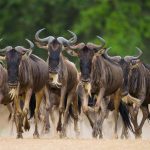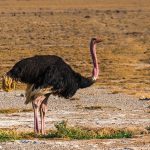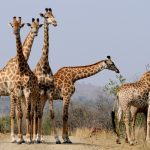Serengeti National Park, recognized as a World Heritage Site, is one of the most famous wildlife areas in the world and is considered the world’s oldest protected ecosystem. Serengeti National Park as we know it today was gazetted in 1951, but a smaller area first received protection by the British between 1921-29 to prevent decimation of the lion population through hunting.
The park itself is 5,700 square miles (about 15000sqkms) but the more extensive Serengeti ecosystem is over 9,600 square miles (25000sqkms) of protected land from Ngorongoro all the way to Loliondo and Kenya (the smaller Maasai Mara), including the Maswa Game Reserve on the southern boundary of the park.
The Serengeti is the largest national park in Tanzania, with a staggering animal population of almost four million and 523 recorded species of bird. It is the largest wildlife sanctuary in the world and the site of one of the most breathtaking events in the animal kingdom—the migration of more than 1.5 million wildebeest and 250,000 zebra.
[smart-grid row_height=”240″ mobile_row_height=”170″ last_row=”justify” margins=”15″ captions=”false” title=”false”]
[/smart-grid]
The area consists of many varied habitats–acacia woodlands, open savannah dotted with granite outcroppings called kopjes, and riverine bush and forest in the north. The park’s name is derived from the Maasai word “SIRINGET” which means endless plains.
The famous wildebeest “migration” that both locals and visitors dream of experiencing is actually an on-going, dynamic process taking a full year to complete. There are also a number of different migratory ‘events’ that take place during the two primary “seasons” in the Serengeti: the green season and the dry season. During the green season (November-June), when there are short periods of rain, usually at night and in the late afternoon, the wildebeest and zebra herds leave the northern part of the Serengeti to travel east and south into the short-grass plains of the central, southern and eastern Serengeti.
The herd traditionally follows two distinct migratory routes, with pregnant females and dominant males moving directly south, through the Seronera area and onward to the short-grass plains of the southern Serengeti. The bachelor males move easterly around the Gol Mountains and then south through the Gol Pass, the Gol Kopjes and onto the southern plains. The female wildebeest need to be in the short-grass plains when they begin to calve as they rely on this particular kind of grass, high in calcium, potassium and magnesium, for calving and milk production. Wildebeest calving can begin at any time between January-March, with over 750,000 females dropping their calves within a 3-week period.
The short-grass plains also offer some of the best protection, as predators are more visible to the herd animals. Herd animals will remain in this area as long as there is sufficient rain in the next few months, although they only need short bursts of rain to be happy.
The wildebeest rut, or breeding season, usually begins at the time of the full moon in April. It extends through the month of May and sometimes into June, depending upon when the rut begins. At this time the herd usually begins to move to the Central Serengeti and will travel large distances seeking the best grazing and water. Some of the most amazing herd sightings occur during the rutting season as the male and female herds reunite for breeding. The herd migration continues both west and north between May and (usually) the end of July. At this point, the herd tends to disperse: males without females may migrate directly north to the Mara River region, while some may move to the famous Western Corridor and remain year-round in the Serengeti.
During the dry season (July-Oct), we recommend significant time in the northern Serengeti if visitors want the opportunity to witness river crossings. The majority of the wildebeest and zebra herds (65%) remain in the Serengeti all year round and often are seen in the areas of Lobo Valley, Bologonja and Kogatende, where grazing remains excellent. However, migrating herds now cross over the Mara River multiple times during the dry season and remain in the area until the short rains signal it is time to move onward.
The central Serengeti is a location to be enjoyed all year round because of the large cat populations. Cats do not follow the migrating herds, so during the dry season they search more actively for food as the migration causes their food sources to dwindle. The Serengeti has the largest population of lions (3,200) in all of Africa, primarily due to the abundance of food. We always recommend spending time in at least two locations in the Serengeti to maximize your wildlife viewing in this huge and spectacular park.






